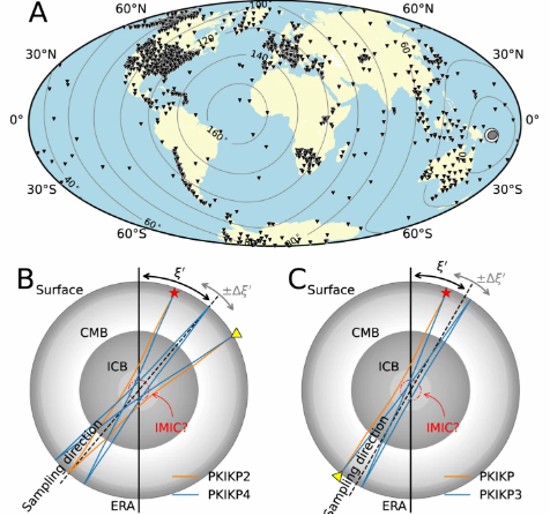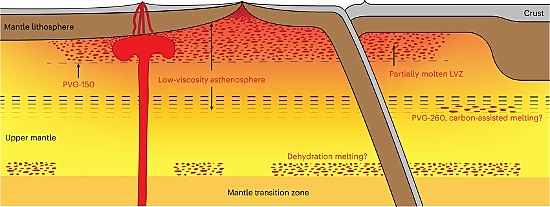In January I wrote about a discovery that the Earth’s core spin rate is slowing down. And now the inner workings of the Earth are once more being publicly written about, a topic usually reserved for scientific journals. This time two new discoveries have recently updated our knowledge about the makeup and characteristics of Earth’s interior.
Before I switched my university major to Medieval and Islamic history, I was pursuing a degree in geophysics. Geophysics studies the Earth and its physical characteristics. Back then my teachers described the inner layers of our planet as follows: there was the lithosphere or Earth’s crust and beneath it lay the mantle, a viscous hot zone that was described as being like a moving conveyor belt of melted rock. Underneath the mantle lay the core, consisting of an outer shell of dense hot liquid iron surrounding a solid iron core.
That picture has changed since the late 1960s with new research using seismic data providing us with a much more detailed model of what lies beneath our feet. It appears now that the mantle doesn’t directly lie beneath the lithosphere. A layer called the asthenosphere is an interface lying between the crust and mantle.
The Asthenosphere is Responsible for Continental Drift
The asthenosphere is a relatively soft boundary between the lithosphere and upper mantle. Junlin Hua, a postdoctoral fellow at the University of Texas – Austin is the lead author of a recently published paper appearing in the journal Nature Geoscience that describes the role the asthenosphere plays in Continental Drift. The paper notes the following:
The asthenosphere extends from 100 kilometres (approximately 60 miles) to 700 kilometres (450 miles) beneath the Earth’s surface. It is described as being malleable, in other words, soft but not necessarily molten. When heat from the mantle causes greater viscosity within the asthenosphere, the continental crustal plates are given the impetus to move. Mind you, the movement of crustal plates is measured in millimetres to centimetres per year where there is geological seismic activity. Earthquakes like the ones that Turkey just had are usually a result of the plates locking together and then releasing in response to physical changes within the asthenosphere.
Scientists Discover Another Earth Core Layer

The Earth has an outer and inner core. The core was first discovered by scientists in 1936. It lies 5,000 kilometres (3,100 miles) beneath the surface of the planet. Measuring 1,220 kilometres (760 miles) across, the core was a mystery until seismologists studying the waves created by earthquakes noted that when passing through the centre of the planet, they slowed down. Subsequently, seismic datasets accumulated over time have allowed researchers to discern subtle changes in speed and direction allowing them to discover the first two core layers and now the innermost.
A study from Australian National University is credited with discovering the innermost core. This solid iron-nickel sphere has anisotropic characteristics. Anisotropic means depending on the sampling angle of seismological data, noticeable changes in the crystalline structure of the metal alloy can be detected. The authors of the study believe this suggests “a significant global event from the past” in which changes occurred to the composition and dynamics of the planet’s interior.
The anisotropic characteristics of the innermost core may be behind the beginning of plate tectonics. The variability within the innermost core structure could have affected the heat flow from the interior to the outermost layers of the planet, ultimately altering the dynamics within the lithosphere.
In our Solar System, plate tectonics is believed to be unique to Earth. There is no evidence of crustal plates on the Moon, Mars, Mercury or Venus. Europa, one of Jupiter’s moons, experiences similar crustal movement but the cause is currents in the ocean that lies beneath the ice crust combined with the pull of Jupiter’s gravity. Jupiter and none of the other gas giant outer planets show evidence of having crustal plates.
So what do we know now about the role of Earth’s core in the dynamics of our planet?
- The core contains three layers, an outer, inner and innermost. The outer is a hot liquid. The inner is solid iron-nickel. The innermost is iron-nickel with crystalline characteristics different from the inner.
- The core spins at a rate sometimes faster and sometimes slower than Earth’s 24-hour daily spin rate.
- The spinning of the core produces the magnetic field that protects life on the planet from cosmic and solar radiation.
- And finally, we are now learning that the compositional characteristics of the newly discovered innermost core could be what initially set Earth’s continents adrift.









